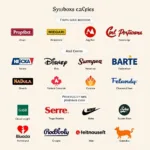Choosing the right lighting can make or break the ambiance of a room. If you’re aiming for a cool, calming, and modern feel, understanding how different lamps influence color temperature is key. So, Which Lamp Produces A Cool Color Tone? Let’s delve into the world of lighting and find out.
Understanding Color Temperature
Before we explore specific lamps, it’s important to grasp the concept of color temperature. Measured in Kelvin (K), it describes the hue of white light emitted by a light source.
-
Warm White (2700K – 3000K): Emits a yellowish, cozy light reminiscent of traditional incandescent bulbs. Ideal for bedrooms and living rooms.
-
Neutral White (3100K – 4000K): Offers a balanced white light, suitable for kitchens, bathrooms, and workspaces.
-
Cool White (4100K – 5000K): Provides a crisp, bluish-white light that mimics daylight. Often preferred for spaces requiring alertness and focus.
-
Daylight (6000K and above): Delivers an intense, almost clinical white light, ideal for tasks demanding high visual acuity.
Lamps That Produce Cool Color Tones
Now, let’s illuminate the types of lamps known for emitting cool color tones:
1. LED Bulbs with High Kelvin Ratings
 LED Bulb with Cool White Light
LED Bulb with Cool White Light
LEDs (Light Emitting Diodes) are incredibly versatile and energy-efficient. When selecting an LED for a cool color tone, look for bulbs with a Kelvin rating of 4000K or higher. These bulbs deliver a crisp, white light that can make a room feel larger and more modern.
2. Fluorescent Bulbs with a “Cool White” Designation
Similar to LEDs, fluorescent bulbs come in various color temperatures. Opt for bulbs labeled “cool white” or “daylight” to achieve that desired cool tone. However, keep in mind that some fluorescent bulbs might emit a slight hum or flicker, which can be bothersome to some.
3. Metal Halide Lamps
Primarily used in commercial settings, metal halide lamps produce an intense, cool white light. Their high lumen output makes them suitable for large spaces like warehouses and stadiums.
Factors to Consider When Choosing Lamps for Cool Color Tones
While the type of bulb plays a crucial role, other factors can influence the perceived color temperature:
-
Room Size and Decor: Cool color tones tend to work better in larger, well-lit spaces. In smaller rooms, they can feel overly stark.
-
Wall Colors: Cool light reflects well off light-colored walls, amplifying the cool tone. Dark walls, however, might absorb some of the light, making the space feel less vibrant.
-
Personal Preference: Ultimately, the best lamp for a cool color tone depends on your individual taste and the specific ambiance you want to create.
Conclusion
Achieving a cool color tone in your space can create a modern, clean, and invigorating atmosphere. By selecting lamps with higher Kelvin ratings, like LEDs or specific fluorescent bulbs, you can easily achieve this effect. Remember to consider factors like room size, wall color, and your personal preferences to find the perfect balance of coolness and comfort.
FAQs
1. Are cool white lights bad for your eyes?
Cool white lights, used in moderation, are generally not harmful to healthy eyes. However, prolonged exposure, especially at night, can interfere with melatonin production, potentially affecting sleep patterns.
2. What are cool color tones best for?
Cool color tones are well-suited for workspaces, kitchens, bathrooms, and any area where focus and clarity are desired. They can also make rooms appear larger and more modern.
3. Can I mix warm and cool light bulbs in the same room?
While it’s generally best to stick to one color temperature for a cohesive look, you can strategically mix warm and cool lights. For instance, use cool white in task areas and warm white in relaxation zones.
4. Are LED lights always cool white?
No, LEDs come in various color temperatures. Check the Kelvin rating on the bulb packaging to determine its color tone.
5. Do cool white lights use more energy?
The energy consumption of a light bulb depends on its wattage, not its color temperature. LEDs, regardless of color tone, are generally more energy-efficient than traditional incandescent bulbs.
Need More Guidance?
Finding the perfect lighting solution can be challenging. Our team at Color Box Hà Nội is here to assist you every step of the way. Contact us at 0373298888 or email us at [email protected]. You can also visit our showroom at 86 Cầu Giấy, Hà Nội. We offer 24/7 customer support to answer your questions and help you create a space that truly shines!

